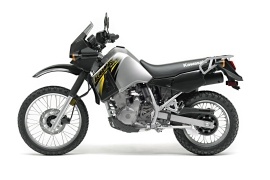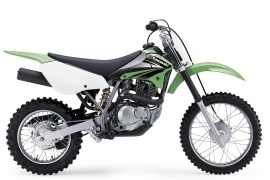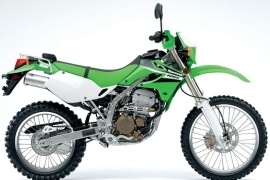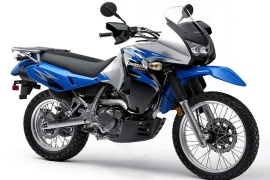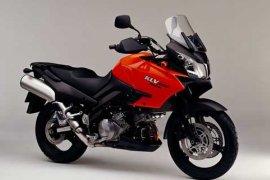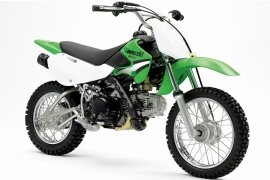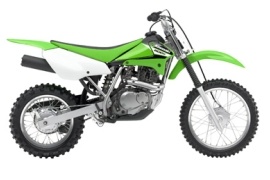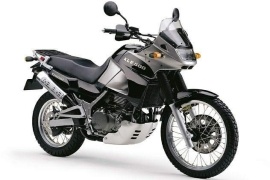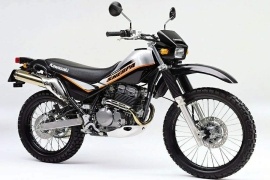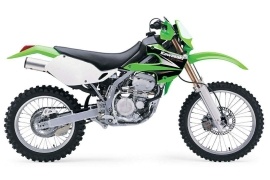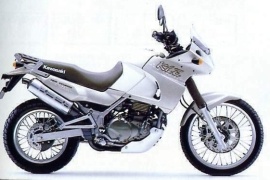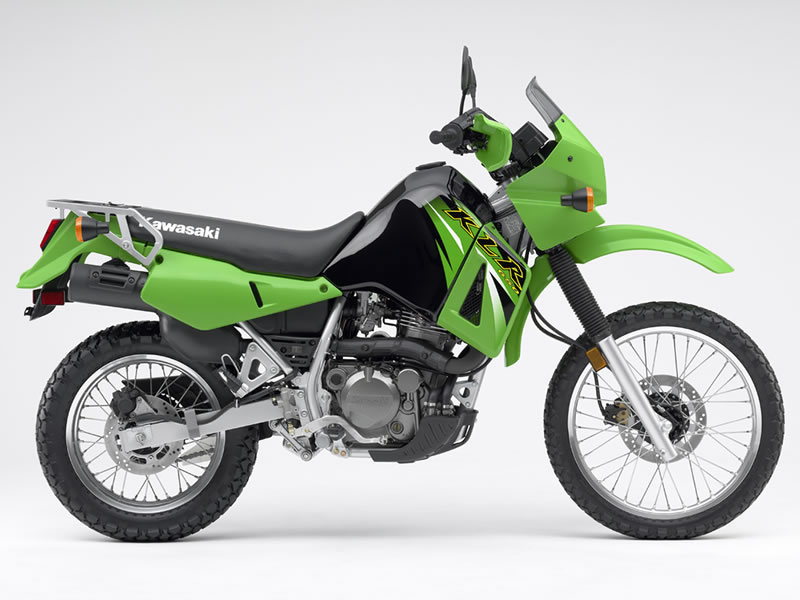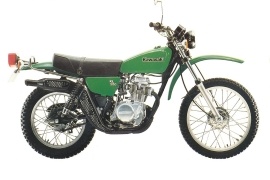KAWASAKI KL Models/Series Timeline, Specifications & Photos
First production year: 1978
The Kawasaki KLR650 was a dual-sports motorcycle that debuted in 1987 and was manufactured over three generations. The first generation was produced from 1987 to 2007, the second from 2008 to 2018, and the third from 2022 to the present (2023).
In 2007, the Japanese motorcycle manufacturer launched the Kawasaki KLR650, the last model in the first generation that featured the same technical, visual, and performance specifications as the previous model.
In the aesthetic department, the motorcycle was equipped with standard features, such as a high-mounted front fender, a half fairing with a rectangular headlight, a small windscreen, a one-piece dual seat, a small luggage rack, and wire-spoke wheels.
In the performance department, the 2007 Kawasaki KLR650 had installed underneath its fuel tank a 651cc four-stroke liquid-cooled single-cylinder engine that delivered an output power of 42 hp with a peak force at 7,000 rpm and 47 Nm (35 lb-ft) torque at 5,000 rpm.
The bike’s power was handled by a five-speed manual transmission with a wet-multi-plate clutch, linked to the rear wheel through a final chain drive, pushing the motorcycle to a top speed of 164 kph (102 mph).
As for handling, the bike was built around a semi-double cradle high-tensile steel frame with a 38 mm air-assisted Kayaba fork on the front, offering 230 mm wheel travel and a five-way preload and four-way rebound-adjustable Kayaba shock absorber on the rear.
It has a responsive air-cooled 125cc four-stroke single, so the KLX 125L pumps out plenty of power for off-road fun. The engine is specially tuned for low and mid-range power.
The Kawasaki KLX is aimed at the gap formed between the mini ranks and the pro classes. The KLX gives adolescent racers an appropriately-sized machine, so they can focus on riding technique instead of on controlling excesses of power.
The Kawasaki KLR650 was a dual-sports motorcycle developed for both on-road and off-road riding and was a long-standing model in Kawasaki's range. The bike was manufactured over three generations, from 1987 to 2007, 2008 to 2018, and 2022 until the present.
The bike replaced the 1984-1986 Kawasaki KLR600 and remained almost unchanged until 2008 when it received its first significant modification. The second considerable modification was in 2022, when it received modern technology, such as a fuel injection system and ABS.
In the visual department, the motorcycle was equipped with standard features, such as a half fairing with a single headlight unit, a high-mounted front fender, a small windscreen, an engine cover, a one-piece dual seat, a medium-sized luggage rack, and wire-spoke wheels.
The bike was built around a semi-double cradle high-tensile steel frame with a 38 mm leading-axle preload-adjustable fork on the front and a uni-trak five-position preload and four-way rebound-adjustable shock absorber on the rear.
In the braking department, the Kawasaki KLR650 was fitted with a 230 mm disc coupled to a hydraulic caliper on the front wheel and a 204 mm disc with a hydraulic caliper on the rear wheel, offering optimum stopping performance.
As for the power figures, the 2004 Kawasaki KLR650 had its soul brought to life by a 651cc four-stroke single-cylinder liquid-cooled engine that delivered an output power of 42 hp at 7,000 rpm and 47 Nm (35 lb-ft) torque at 5,000 rpm.
The Kawasaki KLV1000 was a motorcycle part of the travel enduro category from the Japanese motorcycle manufacturer. The bike was manufactured from 2004 to 2005 and was identical to the Suzuki DL 1000 V-Storm due to the two companies' collaboration.
The bike was manufactured by Suzuki and rolled off their assembly line, but even more, Suzuki was listed as the manufacturer in the KLV1000's vehicle registration document.
In the visual department, the bike was fitted with standard features, such as a half fairing with a dual headlight system, a small windscreen, a one-piece dual seat with passenger grab handles, a high-mounted exhaust system, an engine cowl, and three-spoke lightweight wheels.
Suspension-wise, the motorcycle was fitted with a 43 mm telescopic fork on the front and a swingarm coupled to a preload and rebound-adjustable shock absorber on the rear, delivering optimum suspension performance and handling.
As for the braking power, the bike packed two 310 mm discs coupled to dual-piston calipers on the front wheel and a 260 mm disc with a single-piston caliper on the rear wheel, providing optimum stopping power.
In the performance department, the 2004 Kawasaki KLV1000 had its soul brought to life by a 996cc four-stroke V-twin liquid-cooled engine that delivered an output power of 98 hp at 7,600 rpm and 101 Nm (75 lb-ft) torque at 6,400 rpm.
The 2003 Kawasaki KLX110 is a small-displacement bike for teaching the basics of dirt and motocross racing to kids. The 4-stroke engine is not as powerful and nervous like the 2-stroke ones and this helps children to build up confidence fast and learn how to ride better.
The small dimensions of the 2003 KLX110 provide easy handling and the lightweight steel frame provides the much need sturdiness for fast precise turns. A racing-inspired color scheme makes the bike look as good as is performs.
It has a responsive air-cooled 125cc four-stroke single, so the KLX125 pumps out plenty of power for off-road fun. The engine is specially tuned for low and mid-range power.
The Kawasaki KLE500 was a dual-sports motorcycle manufactured from 1991 until 2007, when it was replaced by the Kawasaki Versys 650, also known as the KLE650. The bike was powered by a 498cc parallel-twin engine and was used on both paved and off-road roads.
In 1999, the Japanese motorcycle manufacturer launched the Kawasaki KLE500, a dual-sports motorcycle fitted with a sump guard to protect the oil pan during off-road use and a small windscreen that protected the smallest riders, exposing the upper torso for taller ones.
In the aesthetic department, the bike was fitted with standard features, such as a half fairing with a small rectangular headlight, a small windscreen, a one-piece dual seat, a small luggage rack, a high-mounted exhaust system, and wire-spoke wheels.
In the suspension department, the motorcycle packed a 41 mm air-assisted telescopic fork on the front and a single shock absorber on the rear, delivering excellent suspension performance and handling capabilities.
As for the braking power, the bike wheels were fitted with a 300 mm disc coupled to a dual-piston caliper on the front and a 230 mm disc tied to a single-piston caliper on the rear, offering optimum stopping power.
Underneath its fuel tank, the 1999 Kawasaki KLE500 had installed a 498cc four-stroke parallel-twin liquid-cooled engine that delivered an output power of 50 hp at 8,500 rpm and 45 Nm (33 lb-ft) torque at 6,500 rpm.
The Kawasaki Super Sherpa was a dual-sports motorcycle known as the KL250G in the American market and the KL250H in the Japanese, Canadian, Australian, Greek, and British markets.
The bike was first offered in Japan in 1997 and sold in the American market from 1999 to 2003. The production and sales continued in Japan, while the maker decided to sell it again in the American market in 2009.
In the visual department, the bike packed standard features, such as a high-mounted front fender, a small rectangular headlight integrated into a small front cowl, a two-piece dual seat with passenger grab handles, a high-mounted exhaust system, and wire-spoke wheels with off-road tires.
The bike was fitted with a very soft suspension system comprised of a telescopic fork on the front and a swingarm coupled to a single-shock absorber on the rear, offering optimum off-road capabilities.
In the braking department, the motorcycle packed a 250 mm disc tied to a dual-piston caliper on the front wheel and a 200 mm disc coupled to a single-piston caliper on the rear wheel, providing optimum braking performance.
As for the power figures, the 1999 Kawasaki KL250 Super Sherpa had installed a 249cc four-stroke single-cylinder air-cooled engine underneath its fuel tank, delivering 30 hp at 8,500 rpm and 26 Nm (19 lb-ft) torque at 7,500 rpm.
The Kawasaki KLX300R was an off-road motorcycle similar to the old Kawasaki KDX200, packing a similar chassis with precise handling, a great suspension system, comfortable ergonomics, and a smooth power-delivering engine for excellent traction on the most challenging trails.
In the appearance department, the Kawasaki KLX300R had equipped standard features, such as a high-mounted front fender, a tiny headlight integrated into a small front cowl, a single seat, a high-mounted exhaust system, and wire-spoke wheels shod with off-road tires.
The 1996 Kawasaki KLX300R had installed underneath its fuel tank a 292cc four-stroke single-cylinder liquid-cooled engine fed by a CVK34 carburetor, boasting 33 hp with a peak force at 8,500 rpm and 28 Nm (21 lb-ft) torque available at 7,500 rpm.
The bike's power was handled by a six-speed manual transmission with a wet multi-disc clutch, spinning the rear wheel through a final chain drive.
The bike was built around a semi-double cradle high tensile steel frame, packing a 43 mm inverted cartridge-type fork on the front and a uni-trak single shock absorber on the rear, offering excellent off-road handling.
In the braking department, the Kawasaki KLX300R had installed a 250 mm disc coupled to a dual-piston caliper on the front wheel and a 220 mm disc with a single-piston caliper on the rear wheel, delivering optimum stopping power.
The Kawasaki KLE500 was a dual-sports motorcycle introduced in 1991 and manufactured until 2007, when it was replaced by the Kawasaki Versys 650 (KLE650). It was powered by a parallel-twin engine and handled both on-road and light off-road conditions.
In 2005, the bike was updated from Euro1 to Euro2 emission standards and included a facelift that rejuvenated the line. The windscreen was redesigned, making it similar to the one used by the Z1000 and Z750 models, turn signals and instrument panel were changed, and the disc brake fairing was removed.
In the visual department, the bike packed standard features, such as a half fairing with a small rectangular headlight, an engine sump guard, a one-piece dual seat large enough to accommodate a passenger, a small luggage rack with passenger grab rails, a high-mounted exhaust system, and wire-spoke wheels.
Suspension-wise, the Kawasaki KLE500 was fitted with a 41 mm air-assisted telescopic fork on the front and a single shock absorber on the rear, delivering optimum on-road and off-road capabilities.
The wire-spoke wheels were fitted with a 300 mm disc coupled to a dual-piston caliper on the front and a 230 mm disc tied to a single-piston caliper on the rear, offering optimum stopping power.
The 1991 Kawasaki KLE500 had a 498cc four-stroke parallel-twin liquid-cooled engine underneath its fuel tank, delivering 50 hp with a peak force at 8,500 rpm and 45 Nm (33 lb-ft) torque at 6,500 rpm.
The Kawasaki KLR650 was a dual-sports motorcycle developed for both on-road and off-road riding. The bike was introduced in 1987 as a replacement for the Kawasaki KLR600 model and was a long-standing model in Kawasaki's line-up.
Over its production time, the Kawasaki KLR650 received two significant redesigns, one in 2008 and another in 2022. The 2022 redesign included modern technology, such as a fuel injection system and Anti-Lock Braking System (ABS).
The KLR model was used as an inexpensive adventure touring motorcycle, while additional luggage systems and personalized modifications, such as GPS, heated grips, and large windscreens, made it more suitable for longer journeys.
In the visual department, the bike was equipped with standard features, such as a high-mounted front fender, a small rectangular headlight in a small front cowl, a one-piece dual seat, a small luggage rack, engine protective bars, and wire-spoke wheels.
The bike was built around a double cradle high tensile steel frame with an air-adjustable telescopic fork on the front and a uni-trak five-way preload and four-way rebound shock absorber on the rear, offering excellent handling capabilities.
In the performance department, the 1987 Kawasaki KLR650 had its heartbeat set by a 651cc four-stroke single-cylinder liquid-cooled engine fed by a Keihin carburetor, delivering 42 hp at 7,000 rpm and 10 Nm (7.3 lb-ft) torque at 5,000 rpm.
The KL250 model was utilized by Air Force Combat Controllers in the USA. The bike has a single cylinder engine with a displacement of 250cc and 28 HP.
